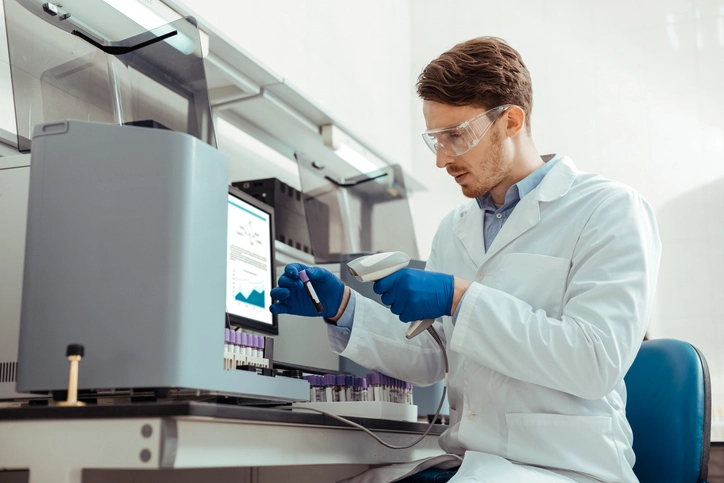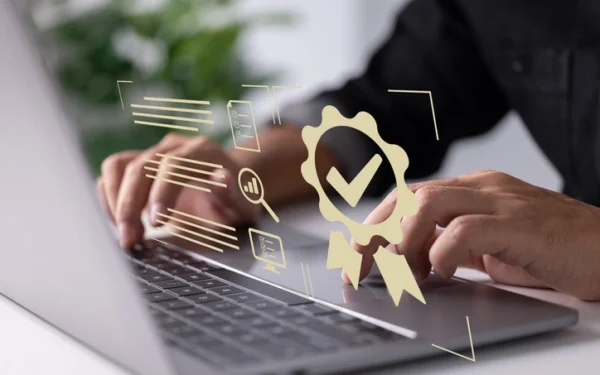Human errors, poor productivity and inefficient collaboration between team members in a laboratory can cause serious issues. Luckily, with the help of modern technology, barcoding offers a solution. These barcodes can easily be printed in the form of a sticker and used to label various items inside your lab. However, it’s important to understand the function and benefits of this strategy within laboratory workflows.
What is lab sample barcoding and why use it?
When a sample enters the laboratory, traditional methods would involve writing down a number on a sticker and sticking it to the sample’s packaging. The number would be entered on a spreadsheet and used to track the sample throughout the laboratory.
However, this opens up opportunities for errors.
Barcoding in the lab involves printing out barcodes and sticking them onto these bottles. These barcodes are already recorded by the LIMS or other laboratory management systems you use, so they will remain connected to a specific patient or project profile.
The benefits include streamlining the process of managing your lab’s inventory, making sample tracking more efficient, and enhancing data collection. Sample barcoding can also improve collaboration in your laboratory. The efficiency that the barcoding process offers enhances the internal workflows in the lab, improving research outcomes and saving costs in the long term.
The benefits of incorporating barcoding in research labs
Barcoding helps lab efficiency and cost-effectiveness
Switching to barcoding in the lab will significantly improve the efficiency of internal operations.
Processes move faster as staff members simply need to scan the barcode when the sample arrives at their workstation, complete their tasks, and then move the sample on to the next person who needs to handle it. Over time, this can become more cost-effective, as you won’t waste time trying to find specific samples.
Barcode scanning also makes it easier to transfer data to a laboratory information management system (LIMS), which can further streamline your lab processes. Sample barcoding makes it much easier to keep track of samples, manage your inventory, and understand when you’re running low on important stock. It can also aid data transfer with data linked to the barcode to help other colleagues in their research.
Different kinds of barcodes can be used in the laboratory, including one-dimensional (1D) and two-dimensional (2D) barcodes. For basic operations, 1D barcodes use a simple, linear design where the width of each line can vary. 2D barcodes can be useful for cases where you’d like to implement additional encryption elements, as they use patterns, different shapes, and dots.
Improved accuracy
The accuracy of your entire workflow will greatly improve when you decide to implement a barcoding system.
When people take notes and associate a specific sample with a number off a spreadsheet, it can cause problems when linking samples to profiles or lead to typing mistakes. In turn, this can affect the accuracy of the data that your lab is able to report.
With barcoding, samples can move through the lab faster. It improves not only the processing of the samples inside the lab but also the sample shipment process. Data can also be easily exported when the barcoding system is integrated with a LIMS that tracks sample data.
Minimizing human error margins
Studies show that human errors can be a common occurrence in labs, especially when using traditional systems, and these errors can lead to major problems.
As a barcoding system will usually integrate with a laboratory information management solution, errors from staff members can be reduced. Instead, the staff member can ensure that they use the correct barcode on every sample that comes into the lab by scanning the barcode. From this point, the system will manage the majority of the processes as long as the staff members scan the barcode at each terminal. This enhances the traceability of the samples through the processes, reduces the room for error and preserves the sample integrity.
Enhanced traceability
With laboratory barcoding, traceability and compliance in your laboratory will become easier, leading to efficient and precise lab operations. The traceability that sample barcoding offers can help ensure that your laboratory keeps up with the demands of the constantly evolving scientific landscape. You’ll be able to get better results not only with sample testing but also with the overall management of samples, inventory and other essential elements in the lab.
If you encounter a problem during the testing procedure, you can easily trace back to where this issue started. You can improve the workflow by going back to that step and seeing what went wrong. Some laboratories have thousands of samples to work through, so manually trying to track everything can lead to errors. The use of intelligent barcodes adds a way to ensure that every sample has a unique code linked to it and is recorded in your LIMS. You can therefore pinpoint the location of one specific sample, even when running a large laboratory.
Increased reproducibility
With a barcoding system, the improved traceability of samples can also help make the tests more reproducible. As many tests must follow a strict set of steps to ensure accurate and efficient testing, with a barcoding system you’ll be able to perfect the workflow for a specific testing procedure and then set it up so that it’s reproduced every time this type of test is requested from your lab.
This can be especially useful in cases where you work with data that can have experimental outcomes. Results may not be the same every time. If there are just slight changes to the process, you may notice alterations in the outcomes. With barcoding, you can easily track specific processes back to each sample to get a more reliable view of testing procedures and then replicate these for better-quality tests in the future.
More effective collaboration
Without effective collaboration in laboratories between staff members, problems can arise and testing processes can be held up, leading to backlogs.
When you integrate a barcoding system in your laboratory, collaboration becomes more effective and streamlined. The barcode is scanned and linked to a profile. When the sample needs to move through the lab, the barcode is assigned to the right personnel. This staff member can scan the barcode and work on the sample, leaving any notes on the system. Once the sample reaches another staff member, they will be able to easily see these notes and take this into account during their part of the testing process.
Apart from internal sharing, sample data can also become valuable when it comes to improving science at a higher level. Scientific communities who are conducting studies or experiments, or creating medical reports, can utilize this type of data to improve the accuracy of their research.
Learn more about lab sample management with the Sapio platform
Sapio Sciences’ lab sample management software is a science-aware platform that can be easily incorporated into your existing laboratory to streamline a wide range of processes.
With the Sapio platform, sample management includes barcoding, which can make productivity in your laboratory much more efficient, reproducible, traceable and accurate. This can lead to efficient and cost-effective laboratory processes. The integrated system gives you solutions that can handle various aspects of the lab, all on a single dashboard. Once samples arrive, simply use the system to print out barcodes. The system will take care of tracking samples, inventory and even equipment throughout your workflow.
If you’re looking to learn more about how Sapio can become a valuable tool in your lab setup, simply reach out to schedule a demo.





